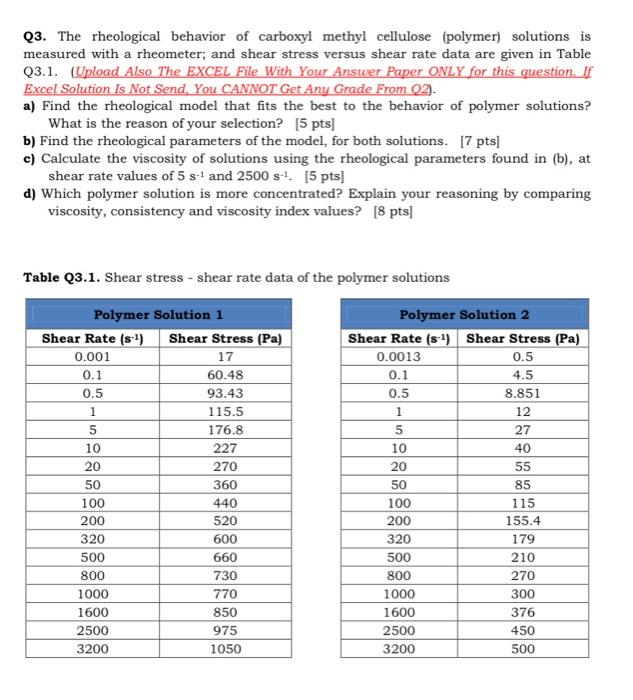Answered step by step
Verified Expert Solution
Question
1 Approved Answer
Please show and describe steps and write clearly, thank you. Fluid Mechanics Question. Q3. The rheological behavior of carboxyl methyl cellulose (polymer) solutions is measured
Please show and describe steps and write clearly, thank you. Fluid Mechanics Question. 
Q3. The rheological behavior of carboxyl methyl cellulose (polymer) solutions is measured with a rheometer; and shear stress versus shear rate data are given in Table Q3.1. (Upload Also The EXCEL File With Your Answer Paper ONLY for this question. If Excel Solution Is Not Send, You CANNOT Get Any Grade From Q2). a) Find the rheological model that fits the best to the behavior of polymer solutions? What is the reason of your selection? [5 pts] b) Find the rheological parameters of the model, for both solutions. [7 pts] c) Calculate the viscosity of solutions using the rheological parameters found in (b), at shear rate values of 5s1 and 2500s1.[5pts] d) Which polymer solution is more concentrated? Explain your reasoning by comparing viscosity, consistency and viscosity index values? [8 pts] Table Q3.1. Shear stress - shear rate data of the polymer solutions Q3. The rheological behavior of carboxyl methyl cellulose (polymer) solutions is measured with a rheometer; and shear stress versus shear rate data are given in Table Q3.1. (Upload Also The EXCEL File With Your Answer Paper ONLY for this question. If Excel Solution Is Not Send, You CANNOT Get Any Grade From Q2). a) Find the rheological model that fits the best to the behavior of polymer solutions? What is the reason of your selection? [5 pts] b) Find the rheological parameters of the model, for both solutions. [7 pts] c) Calculate the viscosity of solutions using the rheological parameters found in (b), at shear rate values of 5s1 and 2500s1.[5pts] d) Which polymer solution is more concentrated? Explain your reasoning by comparing viscosity, consistency and viscosity index values? [8 pts] Table Q3.1. Shear stress - shear rate data of the polymer solutions 
Step by Step Solution
There are 3 Steps involved in it
Step: 1

Get Instant Access to Expert-Tailored Solutions
See step-by-step solutions with expert insights and AI powered tools for academic success
Step: 2

Step: 3

Ace Your Homework with AI
Get the answers you need in no time with our AI-driven, step-by-step assistance
Get Started


